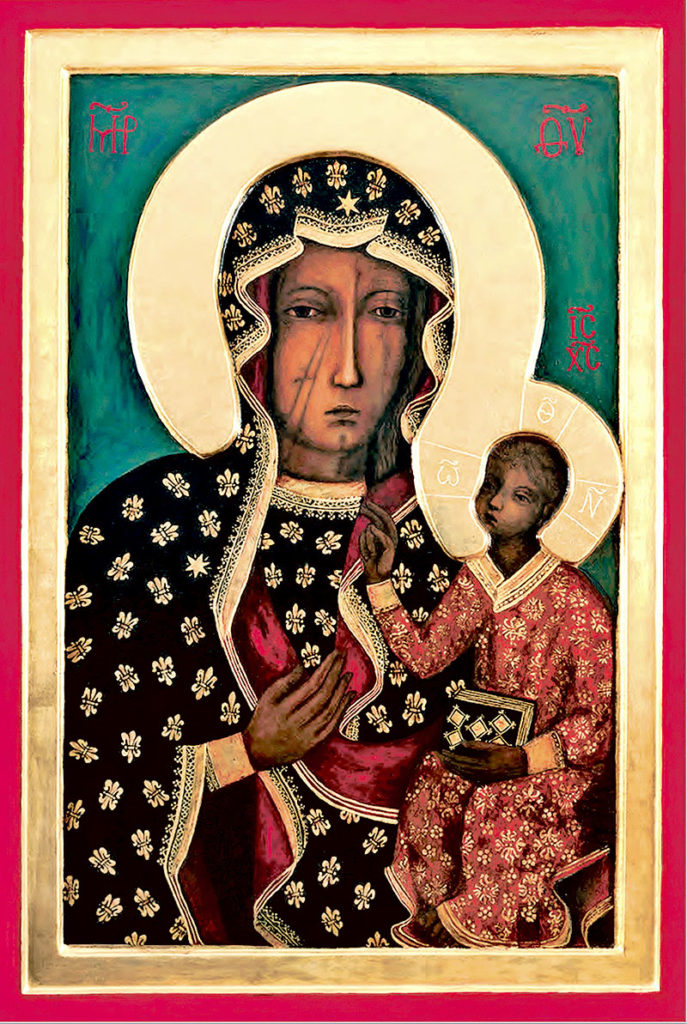
The worship of the Mother Goddess was popular all over the world since ancient times, and is popular today.
The Mother Goddess was usually associated with fertility.
Different cultures worshiped her in different ways, attributing to her aspects similar to their own.
For example, the black people would worship the black Mother Goddess, and the Egyptian people would give her their own religious attributes, and so did Hindus.
In Africa, the Divine Mother is worshiped in many aspects. We find the same to be the case in India. Ancient Greece, Egypt, and Babylon – the inhabitants there also had their own mother goddesses.
In Catholicism, we find Mother Mary representing different aspects of the Mother Goddess. In Hinduism, one deity manifesting as many is a very usual trait. The idols of Catholicism representing the Virgin Mary in actuality represent the Mother Goddess of pagans.

The Mother Goddess of ancient Sumer was Inanna. Her Babylonian equivalent was Ishtar. She was the goddess of love, beauty, sexual desire, wisdom, war, and fertility.
We find a similar representative of this goddess in Haiti voodoo religion too, who was called Ezili Dantor.
Haitian slaves who were forced to convert to Catholicism in the eighteenth and nineteenth centuries continued to worship their voodoo gods under the disguise of the worship of Catholic saints and the Virgin Mary.
They found it easy to worship the Black Madonna because they, I assume, recognized her to be their own deity – even the facial scratches attested to it.

Ezili Dantor, the Black Madonna’s equivalent, was a fierce goddess who was a patron of homosexuals, single mothers, abused women, and children.
She was the goddess of passion, sex, and war and is similar to the Hindu goddess Kali.
People who are used to invoking her report that she, like Kali, needs blood sacrifices to do one’s bidding.
She is described as being fond of knives. This particular deity belongs to the family of water spirits.
She has seven children, as some sources suggest. One of the children is told to be her husband, which is similar to the Tammuz and Semiramis story.
She can be fierce, wild, aggressive, and difficult to control. She is independent and strong.
Here’s a popular song in her honor:
Seven stabs of the knife, seven stabs of the sword,
Hand me that basin, I am going to vomit blood,
The blood runs down…
Although she vomits blood, she continues on. This demonstrates that she would avenge her enemies despite the sustained injuries. When during voodoo rituals, a person becomes possessed by this spirit, they might start vomiting blood.
Ezili Dantor myth tells that there was a long time rivalry between her and her sister Ezili Freda. Her sister represents lasciviousness, flirtation, dissatisfaction in love, and pain. Her Catholic equivalent is the Weeping Mary (Our Lady of Sorrows) with a pierced heart. The reason she’s represented with a pierced heart is as follows.

These two sisters could not stand each other.
There was strong jealousy between them. They both were in love with Ogou Lwa.
They fought over this man and during the battle Ezili Dantor took her dagger which she always carried with her and stabbed Freda in the heart.
That’s, I assume, where we get the Weeping Mary idol from – the stabbed heart was the sign of Ezili Freda.
Freda, in turn, removed the dagger and cut Ezili Dantor’s face, thus scarring her. Thus, you can see the scars on the Santa Barbara Africana image (the right image below), which was painted from the inspiration of the Black Madonna of Częstochowa painting shown below (the left image).
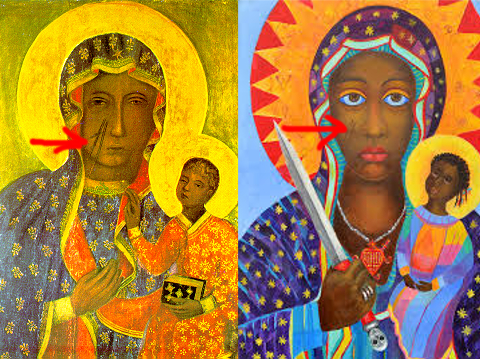
I don’t know if the scratches on the Black Madonna painting indeed point to her voodoo origins, since the official story is different, but this particular image of Madonna indeed looks like that of a fierce tribal warrioress.
This particular spirit, Ezili Dantor, was conjured up in a voodoo ritual carried out by Haitian slaves in 1791.
A black pig was sacrificed to evoke her and drunk by the ritual participants.
Some sources suggest that during this ritual, voodoo priests also made a deal with the devil by writing the contract with pig’s blood in which they dedicated themselves and Haiti to him for 200 years in return for his protection.
When the spirit of Ezili Dantor was conjured up and possessed the voodoo high priestess Marinette, she ordered to kill the French oppressors. This caused the slave revolution.
Her own people cut out her tongue, as they were afraid of her disclosing voodoo secrets if she was caught by the French. She was eventually burnt up alive. On January 1, 1804, the nation of Haiti was born.
This particular spirit likes black pig and black hen blood sacrifices, the offerings of wine, rum, and some beers, daggers, and strong unfiltered cigarettes.
Her days are Tuesday and Saturday. Her Catholic saint associations are: Our Lady of Czestochowa, Mater Salvatoris, Our Lady of Lourdes, Our Lady of Mount Carmel, Our Lady of Prompt Succor, and she is also associated with the Hindu divinity Parvati in her Kali or Chandi aspects.
This last association is also proved by the fact that the gypsy people see their goddess Parvati in Black Madonna paintings. They worship Parvati in a Catholicized way under the pretext of worshiping a girl who helped early Christian missionaries when they were persecuted by Romans in France.
But they themselves know that it’s just a story to continue their Hindu religion abroad, since they themselves unofficially acknowledge to be worshiping their Mother Goddess Parvati (Kali is the fearsome aspect of Parvati) as seen from their personal websites:
St. Sarah, Kali Sara, Sara Kali, Sara-la-Kali, Sati-Sara, The Black Madonna, The Black Mother… many names for one Goddess-Saint sacred to Roma all over the world. She is the Goddess of Fate, good fortune, fertility, and protection– and Roma honor her in pilgrimage, by worshiping her statue, through dance and community… so many ways, so many incarnations of the goddess who accompanied the Roma all the way from India.
GypsyRepresent
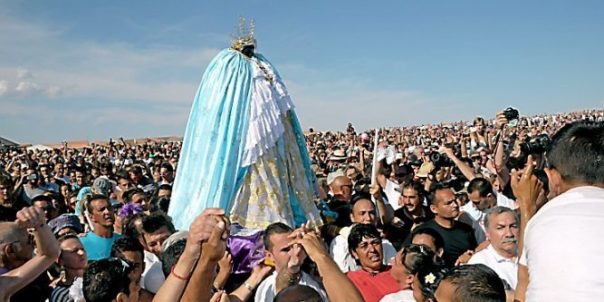
They attend the pilgrimage to Les Saintes Maries in France and other related ceremonies elsewhere honoring black female divinities.
They even worship the Black Mother in the same way that they do back in India – they give offerings to her, and, during festivals, they take their idol into the sea just like the Hindus of India do for their idols (they immerse them into the Ganga river, but now it’s banned).
The North Indians who migrated to Europe and now are called gypsies or Roma people worship their warrior goddess Parvati, as they did when they were in their home country.
Parvati is considered to be the Mother of the Universe. All the other goddesses are sometimes told to represent Parvati’s aspects. For example, her fierce aspect is Kali and her demon-killing form is Durga. Gypsies consider her to be their protectress.
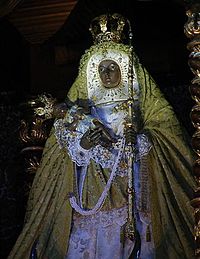
Gypsies simply took their Hindu religion with them into exile, and now worship the same idol they worshiped in their country under the disguise of Catholicism.
The same has been done in Brazil and Cuba to preserve the worship of African ocean spirits such as Yemaya.
These ocean spirits have been blended with the Catholic figure of the Virgin Mary and are now represented by her Our Lady of Regla aspect.
So that is quite funny. Catholicism is all about the worship of pagan deities under the pretense of the Christian religion, and then the converted pagans continue worshiping the same spirits they did in the past. Some of them, I assume, recognize their own worshiped idols in the idols of Catholics, so the transition to another religion becomes almost non-existent.
The Virgin Mary of Catholicism, therefore, is not the mother of Jesus but the Queen of Heaven, the Mother Goddess that was worshiped by pagans for thousands of years. She is worshiped in many cultures under different names and disguises. She’s also worshiped according to her different aspects, which are sometimes represented as different goddesses.
Therefore, the worship of Mary embodies these variations of the Mother Goddess appearance also, and points to the fact that it’s not the human being Mary that is worshiped, but the deity who can shape-shift and is the female aspect of the god of fertility who is called Moloch, Baal, Satan, Shiva, Saturn, Cronos and by many other names in different cultures.

So these two gods (together with their many aspects and manifestations) are the gods of fertility, sex, and war.
That’s what people worship today when they watch violent movies with sexual content and when they pay money to attend music concerts with demonically-dressed performers.
The same gods are worshiped to this day, though the way they are worshiped has been made more subtle. Children and animals are still sacrificed to these spirits, as it always was the case.
Recommended Books:
- Inanna, Queen of Heaven
- The Stories of Inanna Goddess
- Ishtar Goddess
- The Black Madonna
- Kali: The Black Goddess
- Tales of Durga
- Mermaid and other Water Spirit Tales
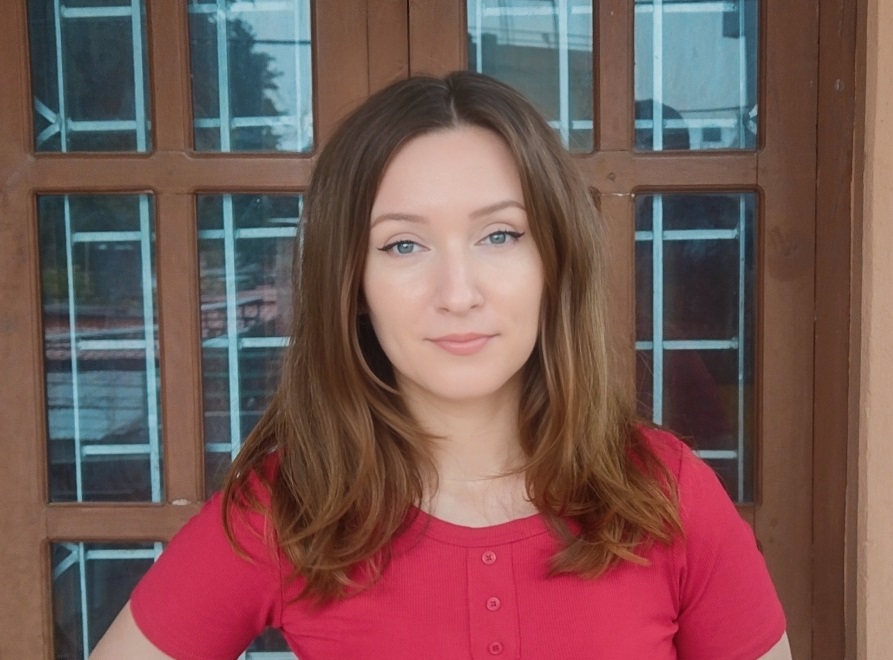
Hi, I'm Simona Rich, the author of this site.
I'm from Lithuania, though most of the time you'll find me somewhere in Asia.
I write about spirituality and self-improvement, and consult on those topics.
Let's connect on Facebook, Instagram and YouTube. My bio is here...

Kinda scary. Do you think all holidays are also pagan? What do you think about Lent, Passover, Ash Wednesday.. and does the Sabbath mean Saturdays? How should we honor the Sabbath? Thanks in advance.
Most holidays are pagan. If they are not mentioned in the Bible, they are pagan. Passover is of God. We no longer need to celebrate the Sabbath, because Jesus is our Sabbath. We enter into His rest when we are saved, dear Ashley.
We should observe the seventh day of the week (Saturday), from even to even, as the Sabbath of the Lord our God. Evening is at sunset when day ends and another day begins. No other day has ever been sanctified as the day of rest. The Sabbath Day begins at sundown on Friday and ends at sundown on Saturday.
Another example of this is looking into Exodus 20:8…
This link may also help….
sabbathtruth.com/faq/advanced-topics/weighing-the-evidence
Sabbath = Rest /Sabbato = Saturday.. Observe the Sabbath day and keep it Holy. The Lord Is the Voice to be heard in the gospel including the five books of moses, which are the Laws directly inspired by the Most Hie our father. Only the Father is Good / Morally excellent so therefore we follow his laws.
Thanks for this … its a very good breakdown of exactly what this entity is ! Baals consort by her/its many other names … Ive walked around the grounds of the massive Kali temple in Dakshineswar, Kolkata, India and prayed the fire of God around that place … this evil demon holds the people of India in great fear & bondage … as it does in all other countries
All of these are great reasons to be a non-believer.
No ” mary”. First madonnas are copies of ancient origins. There is no connections between these images and “biblical” jewish family. As well as ” mother of god” is not from “bible”.Variety of mary-idols are replacing ancient deities